
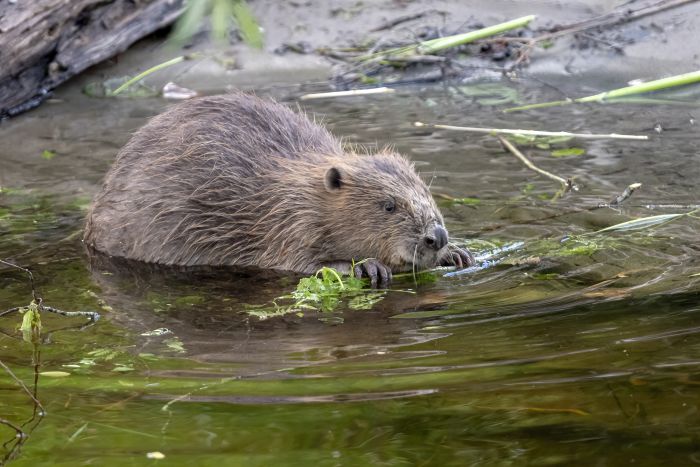
Beaver eating bracken
The industrious and charismatic beaver is slowly being reintroduced into Britain following an absence of around 400 years. While they are certainly endearing and apparently watching them eat cabbage can reduce your stress levels, what does their reappearance mean for Britain’s natural environment and wider society?
In discussions with the environmental journalist and author Ben Goldfarb and the Head of Communications at the Beaver Trust, Eva Bishop, we explored the implications of the reintroduction of beavers in Britain and what their future might look like.
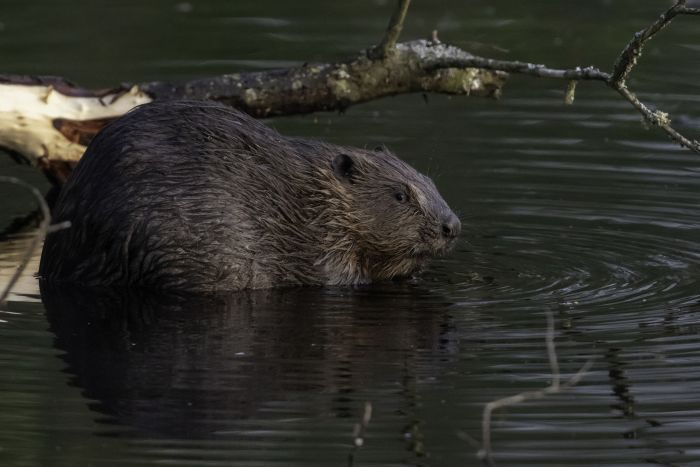
Beaver giving side eye
A herbivorous mammal that can weigh up to 30 kilograms, the beaver is the second largest of the 4,660 known species of rodent worldwide (the capybara is the largest). After evolving around 33 million years ago, the beaver was widespread across most of Europe and northern Asia, inhabiting semi-arid areas in the Mediterranean and Middle East. In Britain, the Eurasian beaver (Castor fiber) used to be prevalent across England, Wales and Scotland; strangely enough, no evidence has ever been found of beavers having lived in Ireland. However, due to a demand for their fur, meat and castoreum — a secretion from their anal glands that is still used today for a range of purposes — the species was driven to extinction by the sixteenth century throughout Europe and Britain.
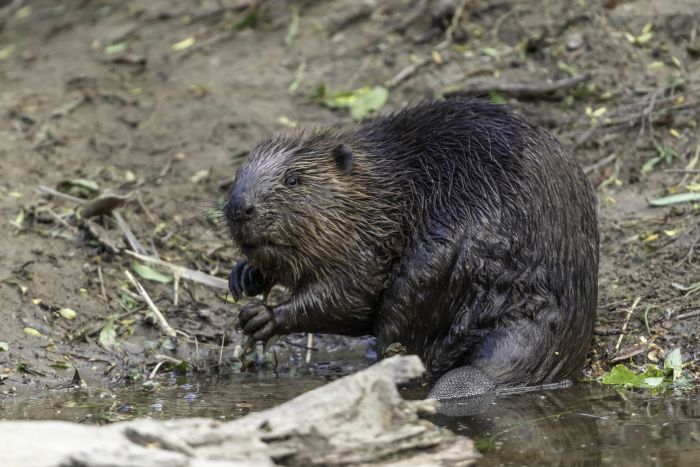
Wild beaver on the River Tay
Aptly described as ecosystem engineers, beavers have an incredible ability to transform rivers and land, creating diverse and intricate wetland habitats. Because of their disproportionately large impact on aquatic ecosystems relative to their numbers, they are also commonly referred to as a keystone species.
In April 2023, I had the pleasure of interviewing Ben Goldfarb, an environmental journalist and author of the award-winning book, Eager: The Surprising, Secret Life of Beavers and Why They Matter. He provided key insights into the effects these aquatic rodents have on their surrounding landscapes, pointing out two particularly significant benefits: increasing biodiversity and reducing the risks of both drought and flooding.
By foraging and felling trees, beavers open the woodland canopy, which allows more sunlight to reach the ground. This increases the diversity of plant, lichen and other species of vegetation on the woodland floor, which boosts the number of predatory species (e.g. insectivorous birds) because there are more feeding opportunities. Similarly, habitat created for invertebrates, such as beetles and fungi, from felled and standing deadwood on land and water supports many species of fish, birds and amphibians.
In fact, research has shown that wetlands created by beavers support a larger diversity of life than wetlands created by other means, with 26% more beetles and 33% more plant species found in the beaver-created wetlands. As the UK has lost more than 75% of its wetlands since 1700 — due in large part to agriculture and urban expansion — beavers are helping to restore these habitats and, in turn, enabling an array of species to flourish.
Referring to extensive research conducted by the University of Exeter to investigate the effects of beavers on the environment, Ben summarized one of the main findings: “Beaver reintroduction [at test sites] enhanced everything in the ecosystem — from dragonflies to water beetles to frogs, there is just this incredible explosion of biodiversity in and around a beaver complex.”
The slowing of water flow caused by the construction of beaver dams has significant benefits, including a reduction in the risks of both flooding and drought. By retaining water behind the dam — in what is known as a beaver pond — which is then slowly released downstream, water flow increases during dry periods and peak flows are reduced during storms. In fact, a multi-site study in England demonstrated that beaver dams can reduce average flood flows after rainstorm events by up to 60%. And due to the leaky nature of beaver dams — whereby water constantly drains, freeing up storage in each pond they create — this flood attenuation effect has even been shown to occur during the wettest times of the year.
Furthermore, by reducing the flow of water, beaver dams cause sediment and organic matter to build up in the ponds they create. As high concentrations of pollutants can enter the water from intensively managed farmland upstream, dams can therefore improve the quality of water downstream for the benefit of humans and wildlife.
As beaver-engineered wetlands boost biodiversity and effectively manage water flow, as well as store large volumes of carbon when actively maintained by the species, beavers provide a natural means of adapting to and mitigating the deleterious effects of climate change. The latest climate science is clear: we must limit global warming to 1.5°C above pre-industrial levels to prevent devastating impacts on people and planet. Encouraging and supporting the reintroduction of beavers therefore makes environmental sense.
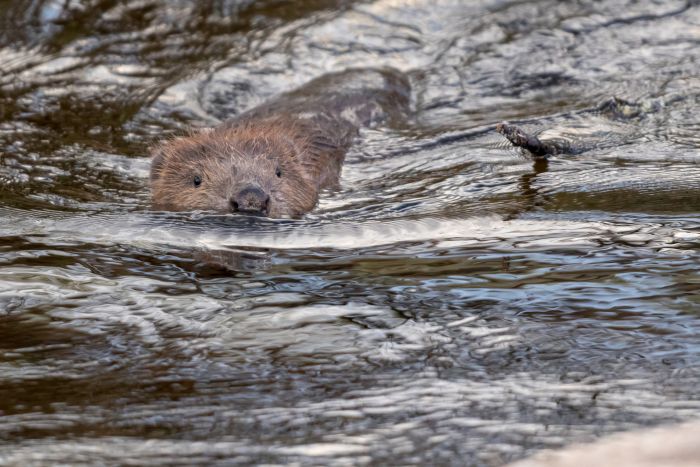
Beaver swimming
Since the 1920s, the beaver has been steadily reintroduced across 28 countries in Europe, and their total population is now estimated at 1.5 million individuals. Britain has been one of the slower parts of Europe to restore the beaver, with the first official reintroduction taking place in Scotland in 2009 as part of the Scottish Beaver Trial. While beavers have escaped into the wild across England and there have been a handful of unlicensed releases, the licensed population of free-living beavers from the 2015 River Otter Beaver Trial (ROBT) is noteworthy.
The researchers reported that the beavers in the five-year ROBT delivered multiple environmental and social benefits and, following a quantitative assessment, these benefits were determined to be greater than the financial costs incurred. As a result, the UK government agreed to allow the beaver population (consisting of approximately 15 families) to stay in the River Otter — a landmark decision as it constituted the first legally sanctioned reintroduction of an extinct native mammal to England.
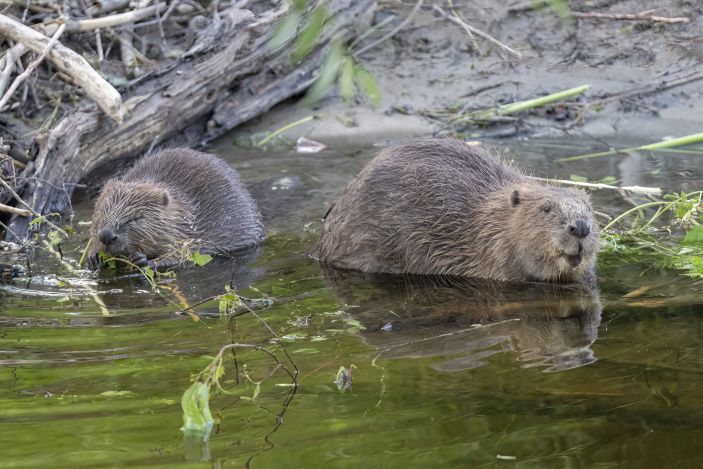
Beavers eating
In 2021, following discussions between Natural England, conservationists and the Department for Environment, Food and Rural Affairs (Defra), an agreement was reached that the widespread reintroduction of beavers across England would have positive environmental implications. The Eurasian beaver was then afforded much-needed legal protection in England through The Beavers (England) Order that came into effect in October 2022: it added the beaver to Schedule 2 of the Conservation of Habitats and Species Regulations 2017, making it an offence to deliberately capture, injure, kill or disturb beavers, or damage or destroy their breeding sites or resting places.
Despite this legislation marking a significant step in the protection of beavers in England — it gives the species the same level of protection granted under Scottish law since 2019 — a wild release licensing framework is lacking. Crucially, this has impeded the widespread reintroduction of beavers in England. Even though the many benefits that beavers provide have been acknowledged, Defra is dragging its feet with respect to encouraging widespread release of the species in England; this is evidenced by the fact that it has not yet opened applications to stakeholders wishing to release beavers into the wild.
“In 2021, Natural England suggested that a favorable population status for beavers would be around 5,200 family groups. We are miles away from achieving this goal. Defra don’t appear to have a clear strategy, and this is preventing us from realizing the significant benefits that beavers could bring to nature and society.”
—Matt Holden, Beaver Project Lead, Devon Wildlife Trust
To understand how widespread reintroduction of beavers could be achieved across Britain, I was fortunate enough to interview Eva Bishop from the Beaver Trust in April 2023. Established in 2019, this small charity is working to restore beaver populations across Britain in order to build landscapes that are resilient to climate change. In her role as Head of Communications, she leads the program that engages and informs the public about river restoration and how to effectively co-exist with beavers.
From speaking with Eva about her work and what she believes is needed to enable beaver populations to flourish, it became clear that we need to learn how to co-exist with beavers once more.
“One of the key things that needs to happen generally is to move toward co-existence. Renewed co-existence is the key message for this species because it [beavers] used to be here [England] and is impactful. We need a mindset shift to give nature space and to learn to live alongside them [beavers] again.”
—Eva Bishop, Head of Communications, Beaver Trust
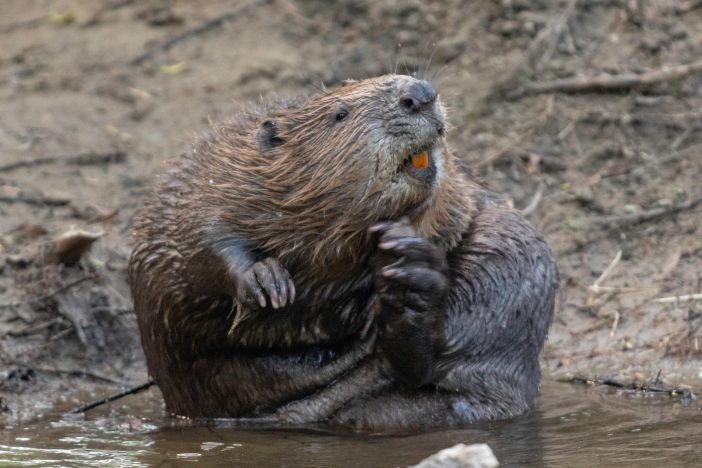
Beaver grooming
While this will not happen overnight and likely requires an array of measures to achieve, the development and implementation of a national-level strategy, as done recently in Scotland, will be key to guiding efforts. Involving a partnership of over 50 stakeholder organizations, Scotland’s Beaver Strategy 2022-2045 aims to expand the range and size of the beaver population across Scotland. By providing clear goals, objectives and actions, the Strategy intends to support and empower communities to maximize the environmental and socioeconomic benefits that beavers bring, while minimizing negative impacts through effective management and mitigation. The Strategy’s detailed implementation plan, which outlines the stakeholders responsible for undertaking certain actions within specific timeframes to meet established goals, is one of the most ambitious and progressive approaches to managing and conserving a species in Britain.
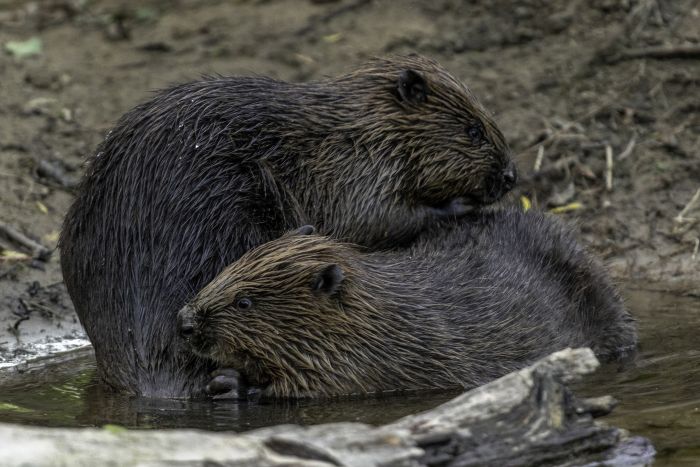
Mutual grooming
According to a recent report by NatureScot, the beaver population in Scotland has expanded rapidly since 2021, with more than 1,500 individual beavers across approximately 424 territories. Assuming this trajectory continues, the prediction is that there could be as many as 10,000 beavers in Scotland by 2030. Aside from the expansion of beaver numbers, the report also highlighted that land managers are actively using alternative forms of management to reduce negative impacts. These results certainly indicate that Scotland’s Beaver Strategy is working, providing strong evidence for an equivalent strategy to be implemented in England and Wales.
Building on the positive legislation changes made in October 2022, and accounting for the highly mobile nature of beavers, Eva stated that “We [England] need a clear steer on a wild release framework, and a management plan and strategy that goes alongside that, so it can be applied consistently across England.”
To support the action being taken at a government level, the formation of so-called “beaver management groups” (BMGs) across Britain will be vital to effectively supporting beaver populations at a local level. These community-driven groups consist of a broad range of stakeholder groups, such as farmers, water companies and conservationists, who will work together to manage the species within their local area. By raising awareness of the importance of beavers and sharing knowledge on how to effectively manage them, the UK government has acknowledged the merits of BMGs and has encouraged every county or region that has wild beavers to establish this type of community group.
Apart from communicating the benefits of beavers and empowering people to protect the species, it is important to ensure that support is easily accessible should an issue arise; for instance, NatureScot has provided a phone number on its website that Scottish residents can call if they have a problem. Depending on the nature of the issue, the environmental agency may send someone out to assess the situation and execute a solution, such as installing a flow device if beaver activity has caused flooding.
Following a survey that the Riverscapes Partnership carried out for Defra, Eva shared that farmers find continued, on-the-ground guidance that is delivered in person particularly helpful. Consequently, more needs to be done to ensure farmers have strong support, as well as to foster collaboration with conservationists and other stakeholder groups to manage beaver populations. By removing barriers to discussion and finding ways to collaborate, stakeholders will be able to reach compromises more easily, ensuring that all parties benefit to some extent from the management and protection of beavers.
“As an individual, the best thing you can do to support the movement
is become better informed about what they [beavers] do.”
—Eva Bishop, Head of Communications, Beaver Trust
Lastly, people at all levels of society need to accept that beavers are a natural part of the environment. Having attended various conferences, Eva revealed that there has been a lot of talk about “the right beaver in the right place,” which means introducing them where they can have the most benefit. However, due to the dispersing nature of the species, she believes it is naive to think this way. By recognizing that the beaver will disperse over time and is a natural element of our landscapes, we will be less resistant to making the changes necessary to see them flourish once again in Britain.
While there is still a lot of work to be done, beaver numbers are bouncing back across Scotland and there are positive signs in other parts of Britain — for example, a baby beaver was recently born in London for the first time in 400 years. There is good reason to feel hopeful and optimistic about the future of this species in Britain. We must all welcome the beaver back with open arms and become beaver believers.
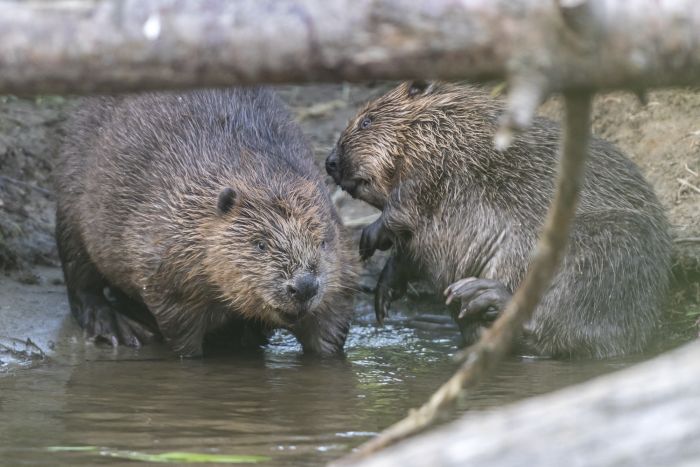
Wild beavers on the River Tay, Scotland
All photos by Elliot McCandless, Courtesy of The Beaver Trust
A. Puttock, et al., “Beaver dams attenuate flow: A multi-site study,” Hydrological Processes Vol. 35 Issue 2, February 2021.
Devon Wildlife Trust, “River Otter Beaver Trial.”
International Union for the Conservation of Nature (IUCN), Scotland’s Beaver Strategy 2022-2045, IUCN Species Survival Commission (SSC)/Conservation Planning Specialist Group (CPSG), 2022.
John Crace, “The Guardian view on England’s east wetlands: wild, beautiful and vital,” The Guardian, April 18, 2023.
M. Elliott et al., Beavers – Nature’s Water Engineers, Devon Wildlife Trust, 2017.
NatureScot, “Report finds more beavers moved as population continues to expand,” June 9, 2023.
Robin McKie, “Beavers are back – but scientists fear Defra’s silence on protection deal,” The Guardian, September 3, 2023.
Stephanie Bird-Halton, “Beavers are now legally protected in England – the licensing regime explained,” Natural England, October 3, 2022.
University of Stirling, “Beaver’s impact on biodiversity revealed,” October 22, 2018.